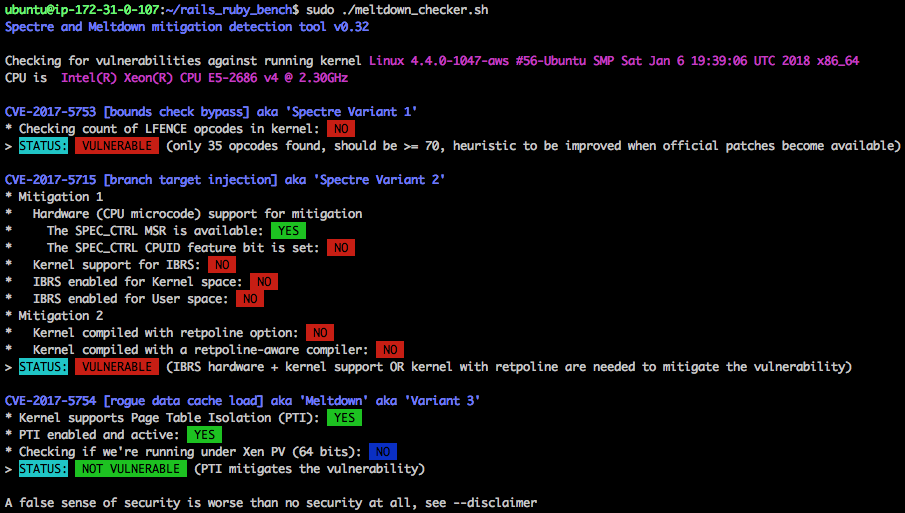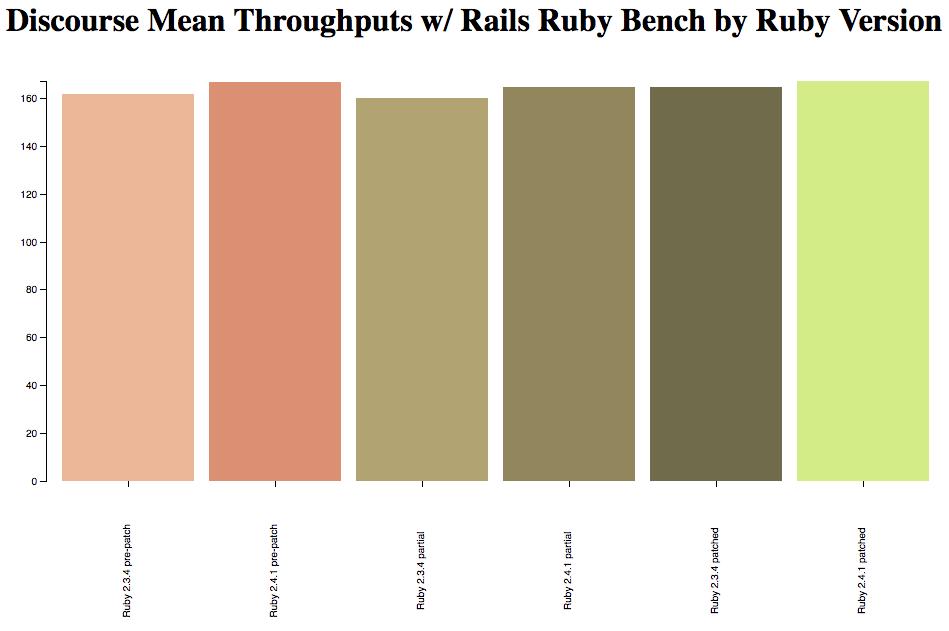How Much Does Meltdown/Spectre Patching Slow Down a Big Rails App?
/You've likely heard about the Meltdown and Spectre bugs that affect nearly all modern CPUs. You've probably heard that the patch to fix them costs some performance. You'll hear between a 5% and 20% penalty or more, depending who you ask and about what benchmark.
So how does that affect Rails Ruby Bench, a highly-parallel real-world Rails workload? Ubuntu now provides patches for Meltdown and Spectre (approximately -- see below), so let's find out!
(Why so late? The original coordinated worldwide release date for Meltdown and Spectre was January 9th but Ubuntu took until January 22nd to release full patches for all three CVEs... Which means I heard about them long before I could patch for them, because the Ubuntu patches weren't out yet. D'oh!)
If I ever become a major security vulnerability, I'm gonna hold a small, picturesque stick just like the "Spectre" ghost.
Old and New
On January 22nd Ubuntu got patches out for all three variants of Meltdown and Spectre -- but with several major disclaimers about hypervisors and hardware. And if you check with a Spectre/Meltdown vulnerability checker, it doesn't look like everything is patched yet for yesterday's Ubuntu Xenial AMI, fully patched, on AWS (see the output below.) So there may be a future slowdown when this is fully patched.
I started from my previous AMI configuration with a beta Discourse 1.8.0 version and Ruby 2.3.4 and 2.4.1. We want a nice well-known baseline for checking this. I have lots of numbers for these Discourse and Ruby versions from before the update. And the Spectre and Meltdown slowdowns depend on the workload, but it's going to be very similar for Discourse 1.9 and Ruby 2.5.
Each of these results is based on 20 batches of 6000 requests for each Ruby/Discourse/patchlevel combination. They're all configured with 30 load-tester threads and 10 server processes, each with 6 server threads. It all runs on an AWS m4.2xlarge dedicated instance but it's not doing network I/O. I used 100 warmups for each process before running the 6000 requests. All of this is my normal config for Rails Ruby Bench, and the configuration I always use unless I have a specific reason to diverge from it. In other words if you've been following this blog, it's the same thing you've been seeing.
So let's look at some numbers (at the next section heading.)
Graphs and Numbers
I have a lot of results for Rails Ruby Bench from before the patch - the results are pretty stable. But I've included some of them here for your reference -- those are the "pre-patch" numbers. I also took some measurements after the January 9th patch but before the Jan 22nd patch. Those are the "partial patch" numbers, which includes both the Ubuntu Jan 9th patch and the AWS server reboot to patch the hypervisors. And finally there are the "patched" numbers, which includes the Jan 22nd patch and is taken based on the latest Jan 22nd official Ubuntu cloud AMI. Again, there may be later patches -- the vulnerability checker does not think everything is taken care of and the Ubuntu announcement has a lot of disclaimers.
Below, have a quick look at the graphs and optionally the table of results. That's... surprising, at least to me. I am not seeing a 5% to 20% decrease in performance. In fact, while there's a bit of a performance hit from the Jan 9th patch, it seems to have bounced back completely to the original performance with the Jan 22nd patch. These are dedicated AWS instances and not doing network I/O outside the instance, so you shouldn't be seeing noisy neighbor problems -- these numbers have been surprisingly stable month by month, so if there were a 5% drop, you'd definitely expect to see it. These results are so close that there may be no difference, it may be entirely swamped by noise in the measurement.
There's a bit of a drop in the middle, but not much. And the right (patched) results are just as fast as pre-patch.
| Ruby Version | Patch Status | Throughput |
|---|---|---|
| 2.3.4 | Pre-patch | 161.8 |
| 2.4.1 | Pre-patch | 166.4 |
| 2.3.4 | Partial | 159.8 |
| 2.4.1 | Partial | 164.6 |
| 2.3.4 | Patched | 164.5 |
| 2.4.1 | Patched | 167.0 |
Conclusions
My guess, based on the data, is that the initial Meltdown and Spectre patches on Jan 9th gave a very small performance penalty, something in the range of 0%-5%, for a large parallel Rails app. But not a lot. It's impossible to tell from this data if that was the Ubuntu patches, the Amazon AWS patches, or both.
But as of Jan 22nd, I am seeing no slowdown whatsoever for concurrent Rails performance with the current Meltdown and Spectre patches. There are reasons to believe that these patches aren't complete (see above.) So it's too early to call it long-term. but I'm not seeing a lot of reason for concern, so far.
Might this be that Rails is I/O-bound? Maybe CPU slowdowns don't matter because Ruby is already so fast that CPU isn't a bottleneck? It's possible, but I don't think so. That same rationale is given every year for why new Ruby changes won't speed up Rails -- Rails does have an I/O-heavy workload, and presumably at some point it will become very hard to optimize it. But Rails on CRuby is still slower than many other web frameworks (e.g. Dropwizard or Torquebox.) And Ruby keeps speeding up Rails every year - with more speedups coming. So I don't think we've hit that point yet, and I definitely don't think a CPU slowdown from Spectre patches would go completely unnoticed.




